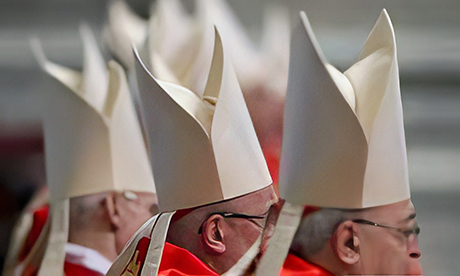The upcoming plenary meeting of the USCCB comes as the Catholic Church is on its way to being, in some ways, a “post-episcopal” Church—no longer a bishops’ Church.
That will likely have a dramatic impact on how Catholicism may influence and interact with American social and political values.
The situation arises from the precipitous drop in vocations.
We still have bishops, priests, and deacons, of course, but there’s no way to imagine a Church in which there’s a priest for every parish—except by importing clergy from other countries.
Meanwhile, a recent study from the Catholic University of America shows a notable drop in the levels of trust and confidence that priests have in their bishops.
This “organisational” schism would be cause for concern in any organization, but especially in a religious one.
Almost two years ago, Pope Francis opened the instituted ministries of lector and acolyte to women, but that has failed to capture the attention of most women who already serve in the Church or would like to.
Among bishops, it has sparked even less enthusiasm.
The same could be said for the creation of the instituted ministry of catechist by Francis in May 2021.
In an evangelizing Church that wants to be all-ministerial, the very idea of ministry is still identified with ordination.
The predicament is even more pronounced for the ministry of bishops.
The post-conciliar crisis of the priesthood and religious orders is not surprising, given the perfunctory treatment Vatican II and its final documents gave to those ministries and their role in the Church.
But the bishop situation is surprising.
Vatican II was not just a council made by the bishops but also in some sense for the bishops: it offered them episcopal collegiality, a new language for local pastoral ministry, more control over diocesan clergy and, especially, over religious orders in their dioceses.
The very celebration of Vatican II was evidence that from thereon, the episcopacy would not only exist but matter.
Synodality
is important in distinct ways.
It’s meant to fill the vacuum left by the bishops,
a vacuum into which other voices and entities
—in media, in business, in politics—have rushed,
and in so doing
have put the catholicity of the Church at risk.
The new USCCB leadership will be at the helm through the 2024 U.S. presidential election, when we may learn how much American Catholic support there is for American democracy.
Signs of an episcopal crisis are obvious:
- the high number of priests who are chosen to become bishops but who decline the appointment;
- the number of bishops resigning because of burnout;
- the cases of bishops quietly removed (and without any transparency, especially for the victims) by the Vatican over accusations or for being found guilty of abuse or cover-up.
This also all has significant impact on ecclesiology and Church governance—especially in the United States, as I’ve noted before, where the bishop’s position has become more managerial and bureaucratic.
Functioning increasingly like the administrator of a mid- or large-sized firm, or even as a CEO overseeing legal, financial, and PR operations, the modern bishop is more and more at odds with the Patristic and Tridentine model that Vatican II had in mind when writing and approving the decree Christus dominus, as well as the constitution Lumen gentium.
Inspiring figures like St Charles Borromeo, bishop of Milan in the early stages of the application of the Council of Trent, commanded a degree of respect in the Church and in the public square that the Catholic episcopate cannot even imagine today.
In some cases, the job of bishop is interpreted to be more like an influencer selling products than a servant of Church unity as Vatican II imagined.
It further translates into a crisis of mission, something that’s become clearer in the course of Francis’s pontificate. Continue reading
